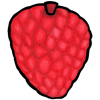Maturity and Quality
- Red Color (due to anthocyanins in the skin) is a good indicator of maturity along with fruit size (minimum of 25 mm in diameter)
- Reaching the optimum range of sugar: acid ratio for the cultivar
- Lychees should be harvested fully-ripe because they do not continue to ripen after harvest
- Bright red color with no brown discoloration even though it is not an indicator of aril quality
- Sweet and juicy aril (edible portion); soluble solids: acid ratio of 30 or higher
- Freedom from defects (such as bird damage, insect damage, physical damage, cracking, and browning) and from decay
- Lychees are excellent source of vitamin C (40 to 90mg/100g fresh weight)
Postharvest Handling and Storage
5°C (41°F), range: 1.5°C to 10°C (35°F to 50°F) depending on cultivar and intended storage duration.
| Temperature | 5°C (41°F) | 10°C (50°F) | 20°C (68°F) |
|---|---|---|---|
| ml CO2/kg·hr | 5-8 | 10-15 | 25-40 |
To calculate heat production multiply ml CO2/kg·hr by 440 to get Btu/ton/day or by 122 to get kcal/metric ton/day.
Ethylene may accelerate deterioration of lychee fruits (aril breakdown and increased decay).
Special Treatment
Color can be preserved by bleaching with SO2 fumigation followed by a dip in dilute hydrochloric acid; but this treatment may induce undesirable aftertaste and is not approved for use on lychee marketed in the U.S.A.
90-95%
Maintenance of high relative humidity is essential for reduction of water loss and browning, which is the major symptom of deterioration.
Less than 0.5 µl/kg·hr at 20°C (68°F)
Lychee is a nonclimacteric fruit.
- Recommended CA: 3-5% O2 and 3-5% CO2
- Benefits include reduced skin browning and polyphenoloxidase activity and slower rates of losses of ascorbic acid, acidity, and soluble solids.
- Modified atmosphere packaging is used commercially to a limited extent.
- Exposure to oxygen levels below 1% and/or carbon dioxide levels above 15% may induce off-flavors and dull gray appearance of the pulp.
Disorders
Pericarp Browning. Water loss (desiccation) of lychees results in brown spots on the bright-red shell (pericarp). Under severe conditions or prolonged exposure, the spots enlarge and coalesce until the surface is completely brown. The flavor of the arils within browned fruit may or may not be adversely affected. Packaging in polymeric films reduces water loss and browning severity.
Chilling injury. Symptoms include pericarp browning (similar to that caused by water loss) and increased susceptibility to decay. Storage at 1°C (34°F) for 12 days before transfer to 20°C (68°F) for one day resulted in pericarp browning.
Pericarp split (cracking). Incidence and severity of cracking depend on cultivar and desiccation during storage. Cracks provide an entry way for decay-causing pathogens.
Aril breakdown. Prolonged storage and overmaturity may cause aril breakdown (softening, loss of turgidity, translucency) and loss of flavor beginning at the blossom end and spreading to the stem end.
Decay-inducing pathogens include Alternaria sp., Aspergillus sp., Botryodiplodia sp., Colletotrichum sp. and various yeasts.
Decay control can be achieved by reducing physical injuries to fruits and by prompt cooling and maintenance of the optimum temperature and relative humidity during lychee marketing.
Other decay control treatments under consideration include use of a 10-15% CO2-enriched atmosphere and biological control.
Disinfestation Treatments
- Irradiation at 0.3 kGy can be used for insect disinfestation purposes with no adverse effects on lychee quality.
- Exposure to heat at 45°C for 30 minutes can be used to control some insects on lychee fruits. Higher temperatures and/or longer exposures to heat damage the fruit.
- Cold treatment (14 days at 1°C) may induce chilling injury (pericarp browning) in some cultivars.



